The Grasslands Nation and the Construction of a Snow Road through the High and Straight Joseph Bighead Reservation
VerifiedAdded on 2022/07/28
|9
|2592
|24
AI Summary
Argue treaty rights of Joseph Bighead First Nation
Contribute Materials
Your contribution can guide someone’s learning journey. Share your
documents today.
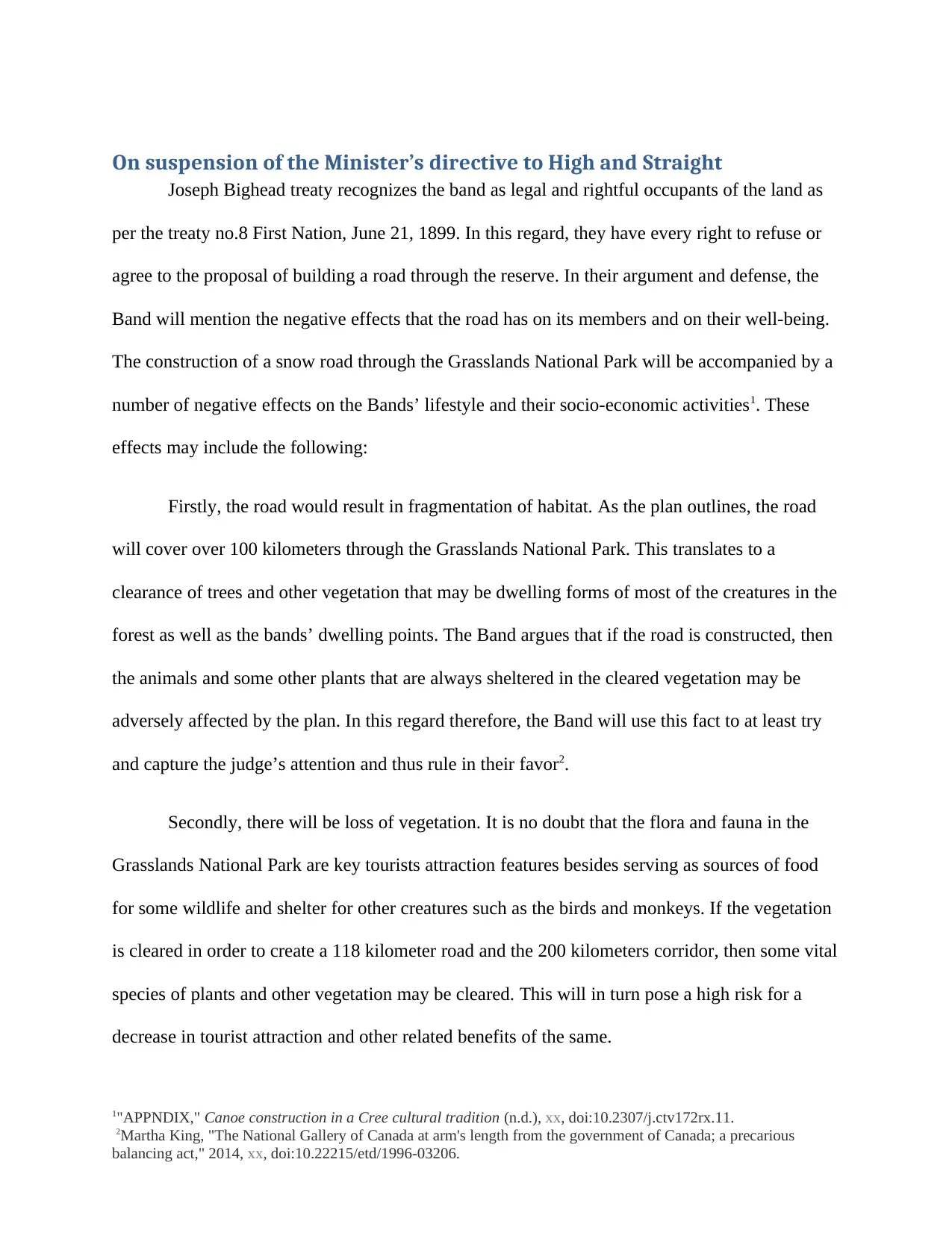
On suspension of the Minister’s directive to High and Straight
Joseph Bighead treaty recognizes the band as legal and rightful occupants of the land as
per the treaty no.8 First Nation, June 21, 1899. In this regard, they have every right to refuse or
agree to the proposal of building a road through the reserve. In their argument and defense, the
Band will mention the negative effects that the road has on its members and on their well-being.
The construction of a snow road through the Grasslands National Park will be accompanied by a
number of negative effects on the Bands’ lifestyle and their socio-economic activities1. These
effects may include the following:
Firstly, the road would result in fragmentation of habitat. As the plan outlines, the road
will cover over 100 kilometers through the Grasslands National Park. This translates to a
clearance of trees and other vegetation that may be dwelling forms of most of the creatures in the
forest as well as the bands’ dwelling points. The Band argues that if the road is constructed, then
the animals and some other plants that are always sheltered in the cleared vegetation may be
adversely affected by the plan. In this regard therefore, the Band will use this fact to at least try
and capture the judge’s attention and thus rule in their favor2.
Secondly, there will be loss of vegetation. It is no doubt that the flora and fauna in the
Grasslands National Park are key tourists attraction features besides serving as sources of food
for some wildlife and shelter for other creatures such as the birds and monkeys. If the vegetation
is cleared in order to create a 118 kilometer road and the 200 kilometers corridor, then some vital
species of plants and other vegetation may be cleared. This will in turn pose a high risk for a
decrease in tourist attraction and other related benefits of the same.
1"APPNDIX," Canoe construction in a Cree cultural tradition (n.d.), xx, doi:10.2307/j.ctv172rx.11.
2Martha King, "The National Gallery of Canada at arm's length from the government of Canada; a precarious
balancing act," 2014, xx, doi:10.22215/etd/1996-03206.
Joseph Bighead treaty recognizes the band as legal and rightful occupants of the land as
per the treaty no.8 First Nation, June 21, 1899. In this regard, they have every right to refuse or
agree to the proposal of building a road through the reserve. In their argument and defense, the
Band will mention the negative effects that the road has on its members and on their well-being.
The construction of a snow road through the Grasslands National Park will be accompanied by a
number of negative effects on the Bands’ lifestyle and their socio-economic activities1. These
effects may include the following:
Firstly, the road would result in fragmentation of habitat. As the plan outlines, the road
will cover over 100 kilometers through the Grasslands National Park. This translates to a
clearance of trees and other vegetation that may be dwelling forms of most of the creatures in the
forest as well as the bands’ dwelling points. The Band argues that if the road is constructed, then
the animals and some other plants that are always sheltered in the cleared vegetation may be
adversely affected by the plan. In this regard therefore, the Band will use this fact to at least try
and capture the judge’s attention and thus rule in their favor2.
Secondly, there will be loss of vegetation. It is no doubt that the flora and fauna in the
Grasslands National Park are key tourists attraction features besides serving as sources of food
for some wildlife and shelter for other creatures such as the birds and monkeys. If the vegetation
is cleared in order to create a 118 kilometer road and the 200 kilometers corridor, then some vital
species of plants and other vegetation may be cleared. This will in turn pose a high risk for a
decrease in tourist attraction and other related benefits of the same.
1"APPNDIX," Canoe construction in a Cree cultural tradition (n.d.), xx, doi:10.2307/j.ctv172rx.11.
2Martha King, "The National Gallery of Canada at arm's length from the government of Canada; a precarious
balancing act," 2014, xx, doi:10.22215/etd/1996-03206.
Secure Best Marks with AI Grader
Need help grading? Try our AI Grader for instant feedback on your assignments.
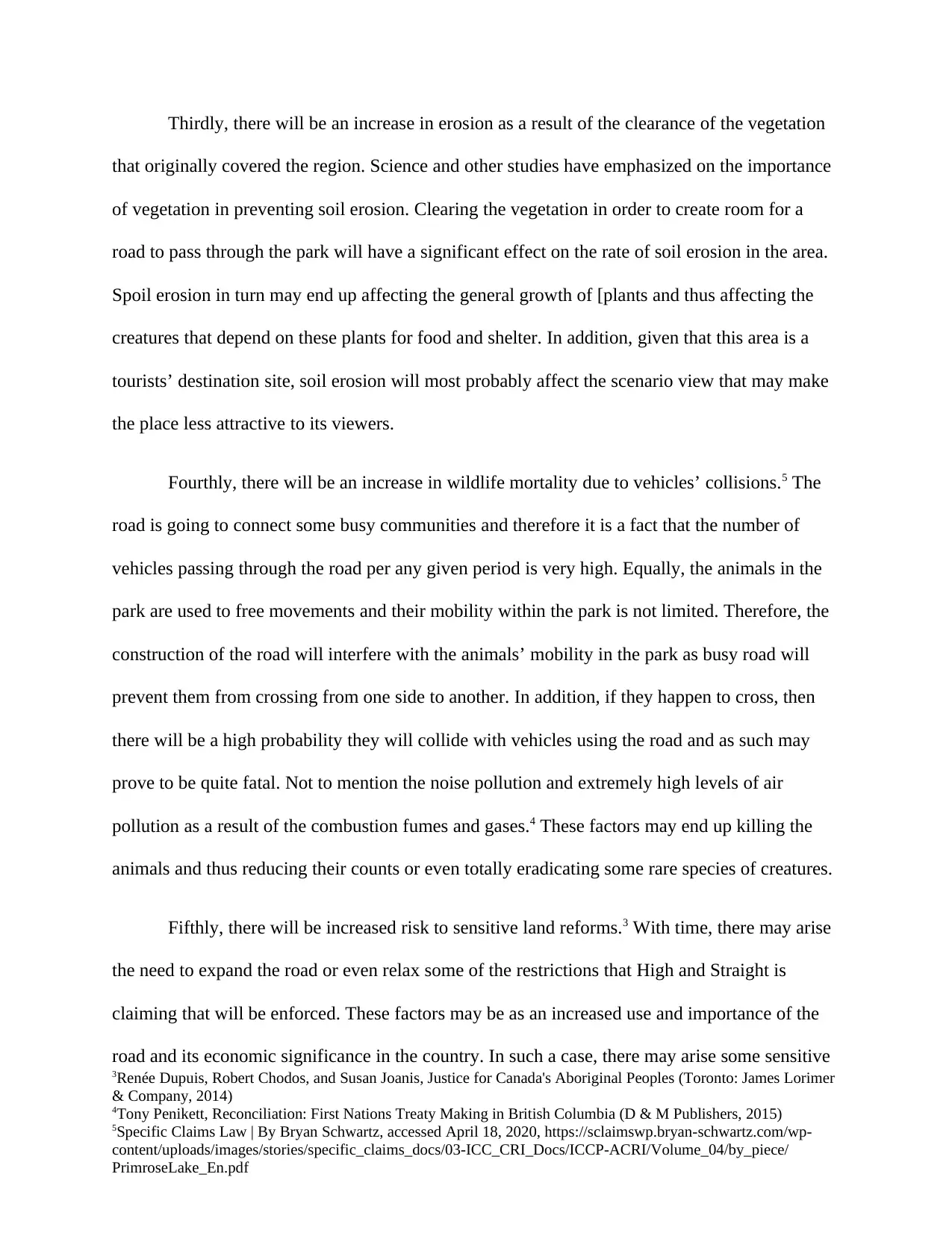
Thirdly, there will be an increase in erosion as a result of the clearance of the vegetation
that originally covered the region. Science and other studies have emphasized on the importance
of vegetation in preventing soil erosion. Clearing the vegetation in order to create room for a
road to pass through the park will have a significant effect on the rate of soil erosion in the area.
Spoil erosion in turn may end up affecting the general growth of [plants and thus affecting the
creatures that depend on these plants for food and shelter. In addition, given that this area is a
tourists’ destination site, soil erosion will most probably affect the scenario view that may make
the place less attractive to its viewers.
Fourthly, there will be an increase in wildlife mortality due to vehicles’ collisions.5 The
road is going to connect some busy communities and therefore it is a fact that the number of
vehicles passing through the road per any given period is very high. Equally, the animals in the
park are used to free movements and their mobility within the park is not limited. Therefore, the
construction of the road will interfere with the animals’ mobility in the park as busy road will
prevent them from crossing from one side to another. In addition, if they happen to cross, then
there will be a high probability they will collide with vehicles using the road and as such may
prove to be quite fatal. Not to mention the noise pollution and extremely high levels of air
pollution as a result of the combustion fumes and gases.4 These factors may end up killing the
animals and thus reducing their counts or even totally eradicating some rare species of creatures.
Fifthly, there will be increased risk to sensitive land reforms.3 With time, there may arise
the need to expand the road or even relax some of the restrictions that High and Straight is
claiming that will be enforced. These factors may be as an increased use and importance of the
road and its economic significance in the country. In such a case, there may arise some sensitive
3Renée Dupuis, Robert Chodos, and Susan Joanis, Justice for Canada's Aboriginal Peoples (Toronto: James Lorimer
& Company, 2014)
4Tony Penikett, Reconciliation: First Nations Treaty Making in British Columbia (D & M Publishers, 2015)
5Specific Claims Law | By Bryan Schwartz, accessed April 18, 2020, https://sclaimswp.bryan-schwartz.com/wp-
content/uploads/images/stories/specific_claims_docs/03-ICC_CRI_Docs/ICCP-ACRI/Volume_04/by_piece/
PrimroseLake_En.pdf
that originally covered the region. Science and other studies have emphasized on the importance
of vegetation in preventing soil erosion. Clearing the vegetation in order to create room for a
road to pass through the park will have a significant effect on the rate of soil erosion in the area.
Spoil erosion in turn may end up affecting the general growth of [plants and thus affecting the
creatures that depend on these plants for food and shelter. In addition, given that this area is a
tourists’ destination site, soil erosion will most probably affect the scenario view that may make
the place less attractive to its viewers.
Fourthly, there will be an increase in wildlife mortality due to vehicles’ collisions.5 The
road is going to connect some busy communities and therefore it is a fact that the number of
vehicles passing through the road per any given period is very high. Equally, the animals in the
park are used to free movements and their mobility within the park is not limited. Therefore, the
construction of the road will interfere with the animals’ mobility in the park as busy road will
prevent them from crossing from one side to another. In addition, if they happen to cross, then
there will be a high probability they will collide with vehicles using the road and as such may
prove to be quite fatal. Not to mention the noise pollution and extremely high levels of air
pollution as a result of the combustion fumes and gases.4 These factors may end up killing the
animals and thus reducing their counts or even totally eradicating some rare species of creatures.
Fifthly, there will be increased risk to sensitive land reforms.3 With time, there may arise
the need to expand the road or even relax some of the restrictions that High and Straight is
claiming that will be enforced. These factors may be as an increased use and importance of the
road and its economic significance in the country. In such a case, there may arise some sensitive
3Renée Dupuis, Robert Chodos, and Susan Joanis, Justice for Canada's Aboriginal Peoples (Toronto: James Lorimer
& Company, 2014)
4Tony Penikett, Reconciliation: First Nations Treaty Making in British Columbia (D & M Publishers, 2015)
5Specific Claims Law | By Bryan Schwartz, accessed April 18, 2020, https://sclaimswp.bryan-schwartz.com/wp-
content/uploads/images/stories/specific_claims_docs/03-ICC_CRI_Docs/ICCP-ACRI/Volume_04/by_piece/
PrimroseLake_En.pdf
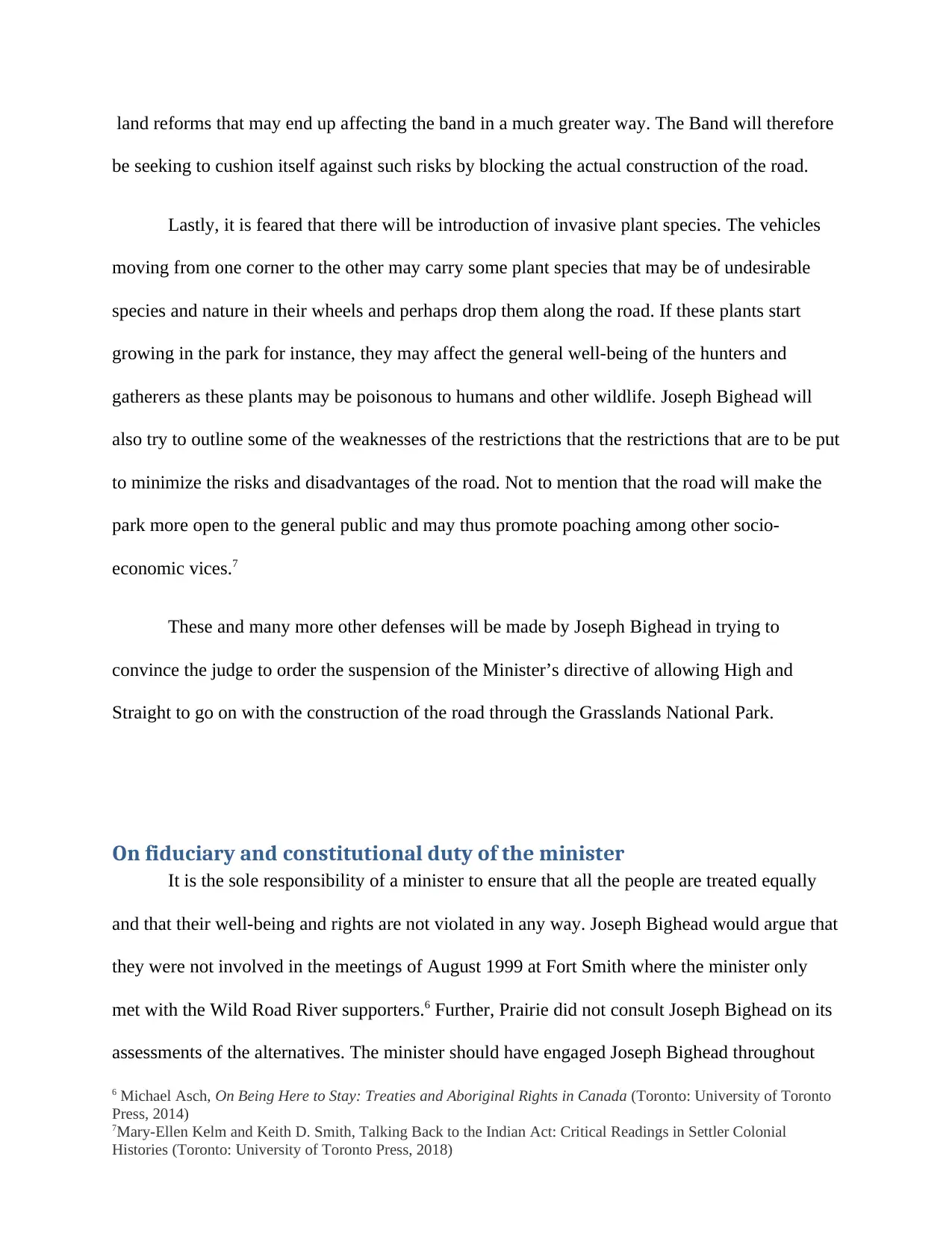
land reforms that may end up affecting the band in a much greater way. The Band will therefore
be seeking to cushion itself against such risks by blocking the actual construction of the road.
Lastly, it is feared that there will be introduction of invasive plant species. The vehicles
moving from one corner to the other may carry some plant species that may be of undesirable
species and nature in their wheels and perhaps drop them along the road. If these plants start
growing in the park for instance, they may affect the general well-being of the hunters and
gatherers as these plants may be poisonous to humans and other wildlife. Joseph Bighead will
also try to outline some of the weaknesses of the restrictions that the restrictions that are to be put
to minimize the risks and disadvantages of the road. Not to mention that the road will make the
park more open to the general public and may thus promote poaching among other socio-
economic vices.7
These and many more other defenses will be made by Joseph Bighead in trying to
convince the judge to order the suspension of the Minister’s directive of allowing High and
Straight to go on with the construction of the road through the Grasslands National Park.
On fiduciary and constitutional duty of the minister
It is the sole responsibility of a minister to ensure that all the people are treated equally
and that their well-being and rights are not violated in any way. Joseph Bighead would argue that
they were not involved in the meetings of August 1999 at Fort Smith where the minister only
met with the Wild Road River supporters.6 Further, Prairie did not consult Joseph Bighead on its
assessments of the alternatives. The minister should have engaged Joseph Bighead throughout
6 Michael Asch, On Being Here to Stay: Treaties and Aboriginal Rights in Canada (Toronto: University of Toronto
Press, 2014)
7Mary-Ellen Kelm and Keith D. Smith, Talking Back to the Indian Act: Critical Readings in Settler Colonial
Histories (Toronto: University of Toronto Press, 2018)
be seeking to cushion itself against such risks by blocking the actual construction of the road.
Lastly, it is feared that there will be introduction of invasive plant species. The vehicles
moving from one corner to the other may carry some plant species that may be of undesirable
species and nature in their wheels and perhaps drop them along the road. If these plants start
growing in the park for instance, they may affect the general well-being of the hunters and
gatherers as these plants may be poisonous to humans and other wildlife. Joseph Bighead will
also try to outline some of the weaknesses of the restrictions that the restrictions that are to be put
to minimize the risks and disadvantages of the road. Not to mention that the road will make the
park more open to the general public and may thus promote poaching among other socio-
economic vices.7
These and many more other defenses will be made by Joseph Bighead in trying to
convince the judge to order the suspension of the Minister’s directive of allowing High and
Straight to go on with the construction of the road through the Grasslands National Park.
On fiduciary and constitutional duty of the minister
It is the sole responsibility of a minister to ensure that all the people are treated equally
and that their well-being and rights are not violated in any way. Joseph Bighead would argue that
they were not involved in the meetings of August 1999 at Fort Smith where the minister only
met with the Wild Road River supporters.6 Further, Prairie did not consult Joseph Bighead on its
assessments of the alternatives. The minister should have engaged Joseph Bighead throughout
6 Michael Asch, On Being Here to Stay: Treaties and Aboriginal Rights in Canada (Toronto: University of Toronto
Press, 2014)
7Mary-Ellen Kelm and Keith D. Smith, Talking Back to the Indian Act: Critical Readings in Settler Colonial
Histories (Toronto: University of Toronto Press, 2018)
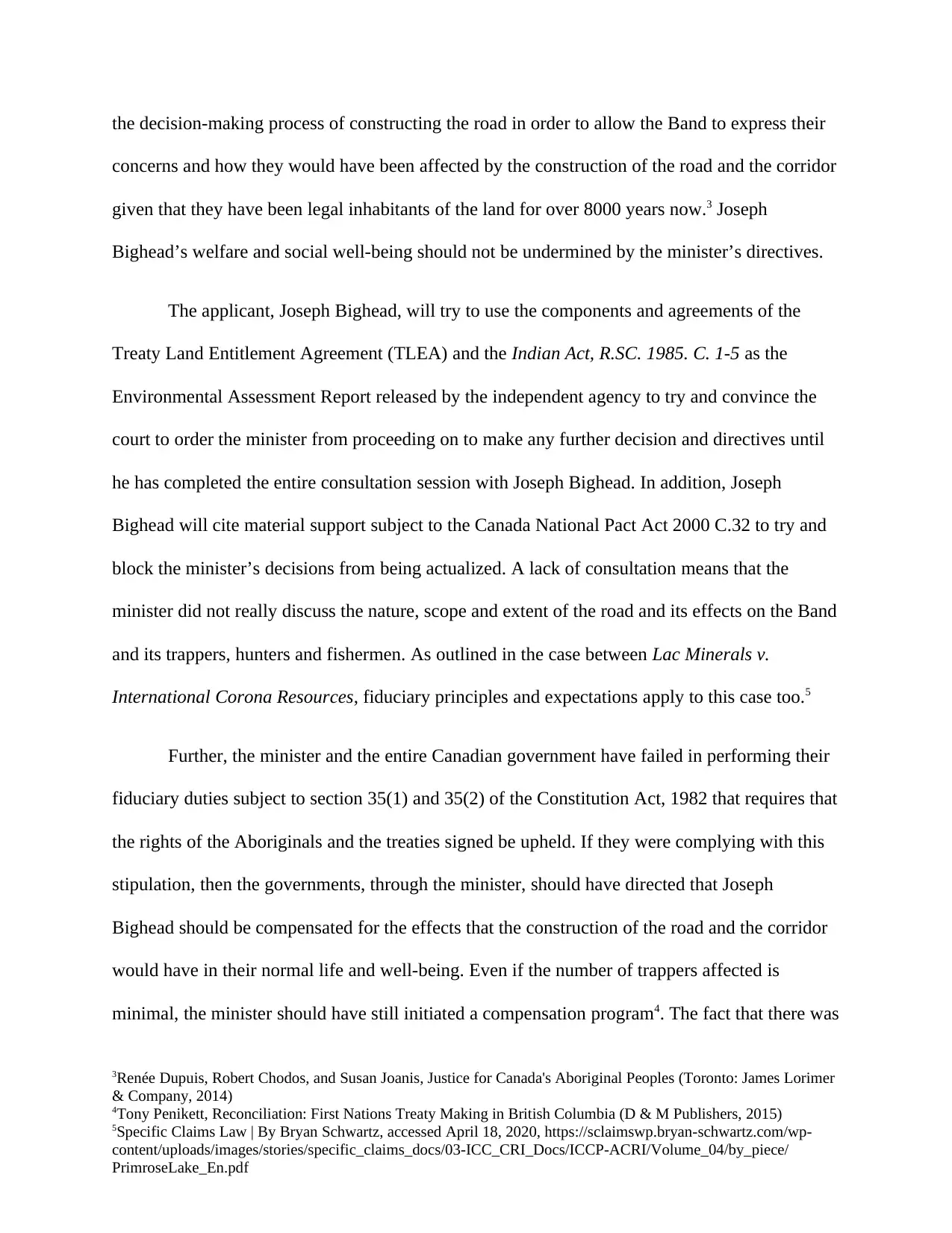
the decision-making process of constructing the road in order to allow the Band to express their
concerns and how they would have been affected by the construction of the road and the corridor
given that they have been legal inhabitants of the land for over 8000 years now.3 Joseph
Bighead’s welfare and social well-being should not be undermined by the minister’s directives.
The applicant, Joseph Bighead, will try to use the components and agreements of the
Treaty Land Entitlement Agreement (TLEA) and the Indian Act, R.SC. 1985. C. 1-5 as the
Environmental Assessment Report released by the independent agency to try and convince the
court to order the minister from proceeding on to make any further decision and directives until
he has completed the entire consultation session with Joseph Bighead. In addition, Joseph
Bighead will cite material support subject to the Canada National Pact Act 2000 C.32 to try and
block the minister’s decisions from being actualized. A lack of consultation means that the
minister did not really discuss the nature, scope and extent of the road and its effects on the Band
and its trappers, hunters and fishermen. As outlined in the case between Lac Minerals v.
International Corona Resources, fiduciary principles and expectations apply to this case too.5
Further, the minister and the entire Canadian government have failed in performing their
fiduciary duties subject to section 35(1) and 35(2) of the Constitution Act, 1982 that requires that
the rights of the Aboriginals and the treaties signed be upheld. If they were complying with this
stipulation, then the governments, through the minister, should have directed that Joseph
Bighead should be compensated for the effects that the construction of the road and the corridor
would have in their normal life and well-being. Even if the number of trappers affected is
minimal, the minister should have still initiated a compensation program4. The fact that there was
3Renée Dupuis, Robert Chodos, and Susan Joanis, Justice for Canada's Aboriginal Peoples (Toronto: James Lorimer
& Company, 2014)
4Tony Penikett, Reconciliation: First Nations Treaty Making in British Columbia (D & M Publishers, 2015)
5Specific Claims Law | By Bryan Schwartz, accessed April 18, 2020, https://sclaimswp.bryan-schwartz.com/wp-
content/uploads/images/stories/specific_claims_docs/03-ICC_CRI_Docs/ICCP-ACRI/Volume_04/by_piece/
PrimroseLake_En.pdf
concerns and how they would have been affected by the construction of the road and the corridor
given that they have been legal inhabitants of the land for over 8000 years now.3 Joseph
Bighead’s welfare and social well-being should not be undermined by the minister’s directives.
The applicant, Joseph Bighead, will try to use the components and agreements of the
Treaty Land Entitlement Agreement (TLEA) and the Indian Act, R.SC. 1985. C. 1-5 as the
Environmental Assessment Report released by the independent agency to try and convince the
court to order the minister from proceeding on to make any further decision and directives until
he has completed the entire consultation session with Joseph Bighead. In addition, Joseph
Bighead will cite material support subject to the Canada National Pact Act 2000 C.32 to try and
block the minister’s decisions from being actualized. A lack of consultation means that the
minister did not really discuss the nature, scope and extent of the road and its effects on the Band
and its trappers, hunters and fishermen. As outlined in the case between Lac Minerals v.
International Corona Resources, fiduciary principles and expectations apply to this case too.5
Further, the minister and the entire Canadian government have failed in performing their
fiduciary duties subject to section 35(1) and 35(2) of the Constitution Act, 1982 that requires that
the rights of the Aboriginals and the treaties signed be upheld. If they were complying with this
stipulation, then the governments, through the minister, should have directed that Joseph
Bighead should be compensated for the effects that the construction of the road and the corridor
would have in their normal life and well-being. Even if the number of trappers affected is
minimal, the minister should have still initiated a compensation program4. The fact that there was
3Renée Dupuis, Robert Chodos, and Susan Joanis, Justice for Canada's Aboriginal Peoples (Toronto: James Lorimer
& Company, 2014)
4Tony Penikett, Reconciliation: First Nations Treaty Making in British Columbia (D & M Publishers, 2015)
5Specific Claims Law | By Bryan Schwartz, accessed April 18, 2020, https://sclaimswp.bryan-schwartz.com/wp-
content/uploads/images/stories/specific_claims_docs/03-ICC_CRI_Docs/ICCP-ACRI/Volume_04/by_piece/
PrimroseLake_En.pdf
Secure Best Marks with AI Grader
Need help grading? Try our AI Grader for instant feedback on your assignments.
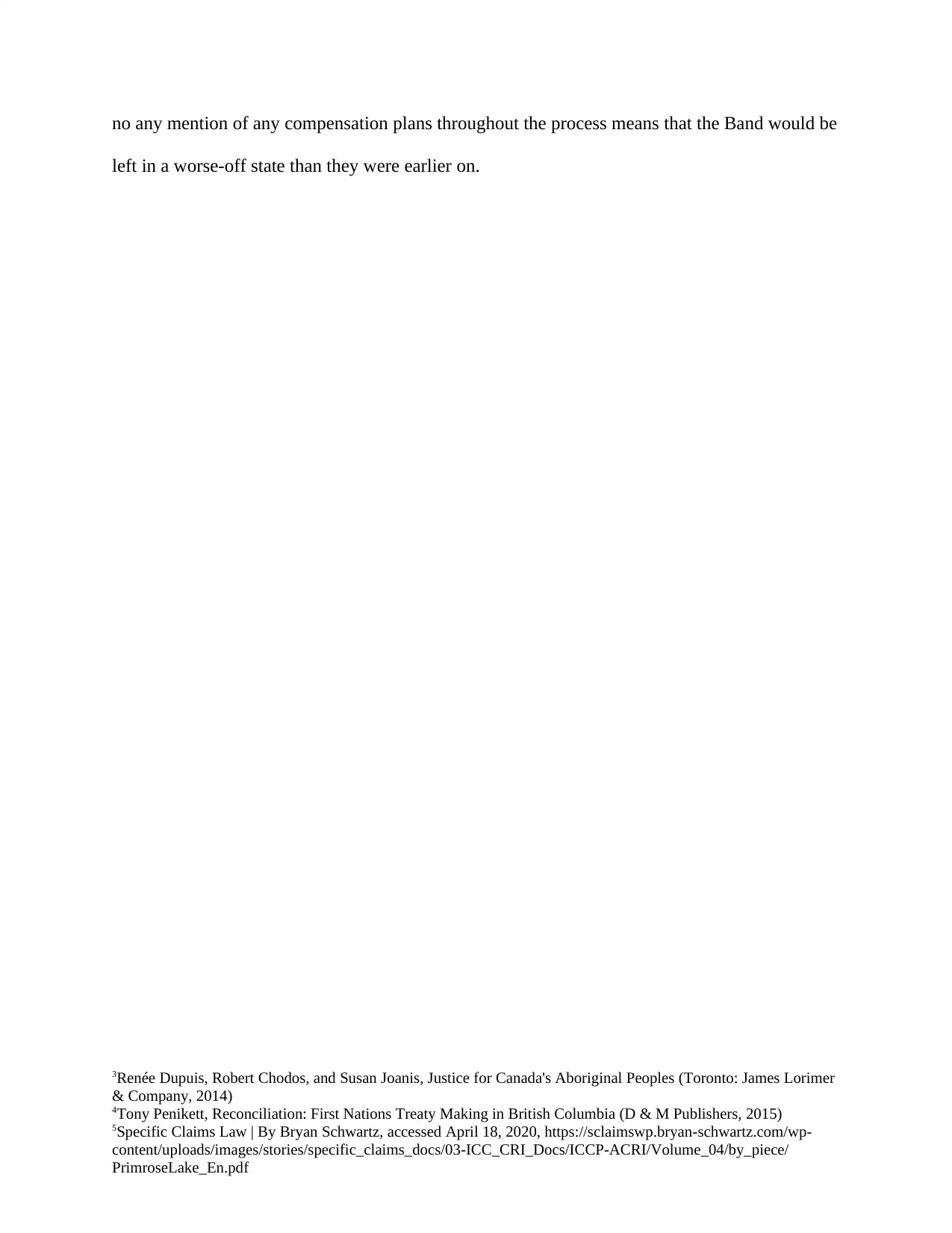
no any mention of any compensation plans throughout the process means that the Band would be
left in a worse-off state than they were earlier on.
3Renée Dupuis, Robert Chodos, and Susan Joanis, Justice for Canada's Aboriginal Peoples (Toronto: James Lorimer
& Company, 2014)
4Tony Penikett, Reconciliation: First Nations Treaty Making in British Columbia (D & M Publishers, 2015)
5Specific Claims Law | By Bryan Schwartz, accessed April 18, 2020, https://sclaimswp.bryan-schwartz.com/wp-
content/uploads/images/stories/specific_claims_docs/03-ICC_CRI_Docs/ICCP-ACRI/Volume_04/by_piece/
PrimroseLake_En.pdf
left in a worse-off state than they were earlier on.
3Renée Dupuis, Robert Chodos, and Susan Joanis, Justice for Canada's Aboriginal Peoples (Toronto: James Lorimer
& Company, 2014)
4Tony Penikett, Reconciliation: First Nations Treaty Making in British Columbia (D & M Publishers, 2015)
5Specific Claims Law | By Bryan Schwartz, accessed April 18, 2020, https://sclaimswp.bryan-schwartz.com/wp-
content/uploads/images/stories/specific_claims_docs/03-ICC_CRI_Docs/ICCP-ACRI/Volume_04/by_piece/
PrimroseLake_En.pdf
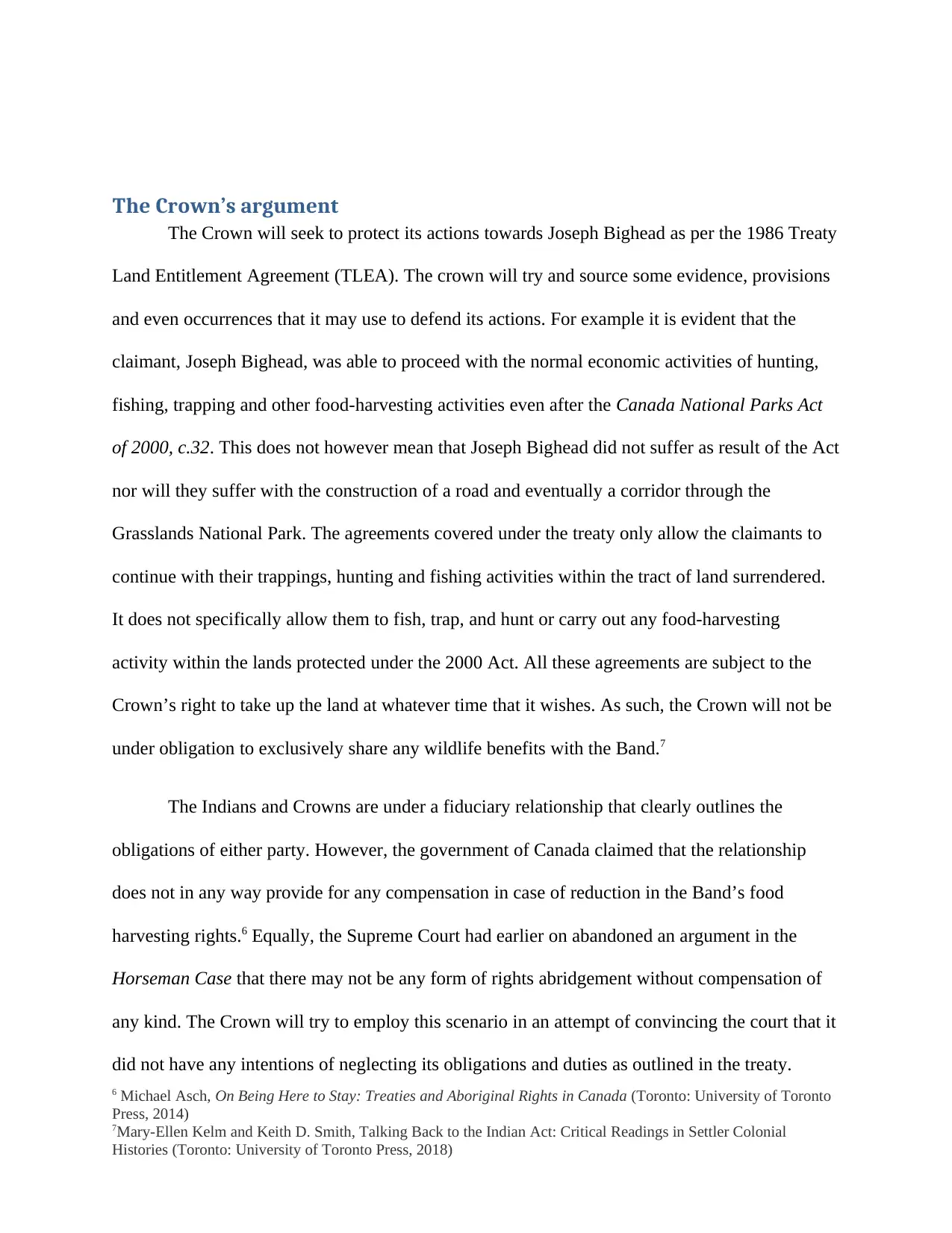
The Crown’s argument
The Crown will seek to protect its actions towards Joseph Bighead as per the 1986 Treaty
Land Entitlement Agreement (TLEA). The crown will try and source some evidence, provisions
and even occurrences that it may use to defend its actions. For example it is evident that the
claimant, Joseph Bighead, was able to proceed with the normal economic activities of hunting,
fishing, trapping and other food-harvesting activities even after the Canada National Parks Act
of 2000, c.32. This does not however mean that Joseph Bighead did not suffer as result of the Act
nor will they suffer with the construction of a road and eventually a corridor through the
Grasslands National Park. The agreements covered under the treaty only allow the claimants to
continue with their trappings, hunting and fishing activities within the tract of land surrendered.
It does not specifically allow them to fish, trap, and hunt or carry out any food-harvesting
activity within the lands protected under the 2000 Act. All these agreements are subject to the
Crown’s right to take up the land at whatever time that it wishes. As such, the Crown will not be
under obligation to exclusively share any wildlife benefits with the Band.7
The Indians and Crowns are under a fiduciary relationship that clearly outlines the
obligations of either party. However, the government of Canada claimed that the relationship
does not in any way provide for any compensation in case of reduction in the Band’s food
harvesting rights.6 Equally, the Supreme Court had earlier on abandoned an argument in the
Horseman Case that there may not be any form of rights abridgement without compensation of
any kind. The Crown will try to employ this scenario in an attempt of convincing the court that it
did not have any intentions of neglecting its obligations and duties as outlined in the treaty.
6 Michael Asch, On Being Here to Stay: Treaties and Aboriginal Rights in Canada (Toronto: University of Toronto
Press, 2014)
7Mary-Ellen Kelm and Keith D. Smith, Talking Back to the Indian Act: Critical Readings in Settler Colonial
Histories (Toronto: University of Toronto Press, 2018)
The Crown will seek to protect its actions towards Joseph Bighead as per the 1986 Treaty
Land Entitlement Agreement (TLEA). The crown will try and source some evidence, provisions
and even occurrences that it may use to defend its actions. For example it is evident that the
claimant, Joseph Bighead, was able to proceed with the normal economic activities of hunting,
fishing, trapping and other food-harvesting activities even after the Canada National Parks Act
of 2000, c.32. This does not however mean that Joseph Bighead did not suffer as result of the Act
nor will they suffer with the construction of a road and eventually a corridor through the
Grasslands National Park. The agreements covered under the treaty only allow the claimants to
continue with their trappings, hunting and fishing activities within the tract of land surrendered.
It does not specifically allow them to fish, trap, and hunt or carry out any food-harvesting
activity within the lands protected under the 2000 Act. All these agreements are subject to the
Crown’s right to take up the land at whatever time that it wishes. As such, the Crown will not be
under obligation to exclusively share any wildlife benefits with the Band.7
The Indians and Crowns are under a fiduciary relationship that clearly outlines the
obligations of either party. However, the government of Canada claimed that the relationship
does not in any way provide for any compensation in case of reduction in the Band’s food
harvesting rights.6 Equally, the Supreme Court had earlier on abandoned an argument in the
Horseman Case that there may not be any form of rights abridgement without compensation of
any kind. The Crown will try to employ this scenario in an attempt of convincing the court that it
did not have any intentions of neglecting its obligations and duties as outlined in the treaty.
6 Michael Asch, On Being Here to Stay: Treaties and Aboriginal Rights in Canada (Toronto: University of Toronto
Press, 2014)
7Mary-Ellen Kelm and Keith D. Smith, Talking Back to the Indian Act: Critical Readings in Settler Colonial
Histories (Toronto: University of Toronto Press, 2018)
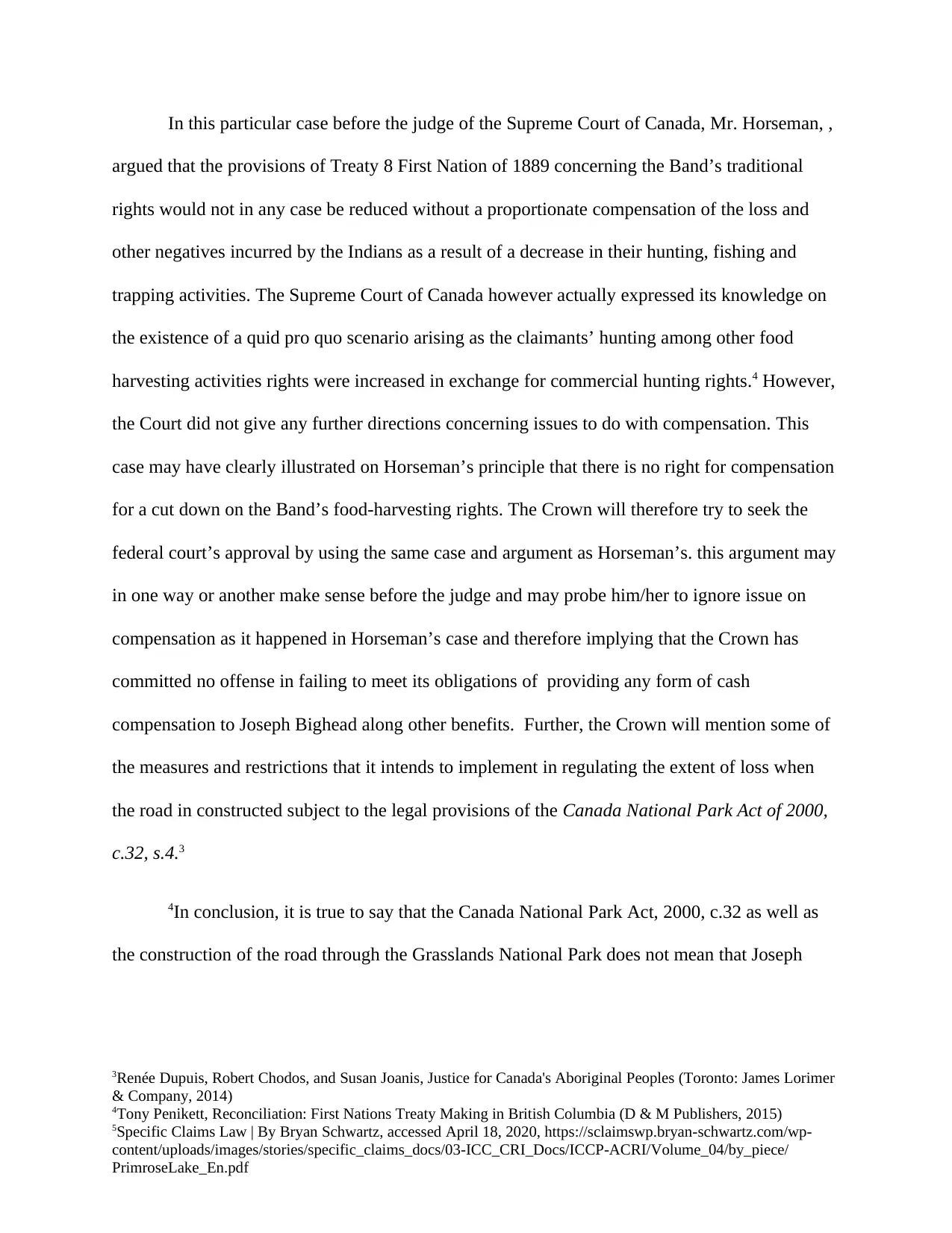
In this particular case before the judge of the Supreme Court of Canada, Mr. Horseman, ,
argued that the provisions of Treaty 8 First Nation of 1889 concerning the Band’s traditional
rights would not in any case be reduced without a proportionate compensation of the loss and
other negatives incurred by the Indians as a result of a decrease in their hunting, fishing and
trapping activities. The Supreme Court of Canada however actually expressed its knowledge on
the existence of a quid pro quo scenario arising as the claimants’ hunting among other food
harvesting activities rights were increased in exchange for commercial hunting rights.4 However,
the Court did not give any further directions concerning issues to do with compensation. This
case may have clearly illustrated on Horseman’s principle that there is no right for compensation
for a cut down on the Band’s food-harvesting rights. The Crown will therefore try to seek the
federal court’s approval by using the same case and argument as Horseman’s. this argument may
in one way or another make sense before the judge and may probe him/her to ignore issue on
compensation as it happened in Horseman’s case and therefore implying that the Crown has
committed no offense in failing to meet its obligations of providing any form of cash
compensation to Joseph Bighead along other benefits. Further, the Crown will mention some of
the measures and restrictions that it intends to implement in regulating the extent of loss when
the road in constructed subject to the legal provisions of the Canada National Park Act of 2000,
c.32, s.4.3
4In conclusion, it is true to say that the Canada National Park Act, 2000, c.32 as well as
the construction of the road through the Grasslands National Park does not mean that Joseph
3Renée Dupuis, Robert Chodos, and Susan Joanis, Justice for Canada's Aboriginal Peoples (Toronto: James Lorimer
& Company, 2014)
4Tony Penikett, Reconciliation: First Nations Treaty Making in British Columbia (D & M Publishers, 2015)
5Specific Claims Law | By Bryan Schwartz, accessed April 18, 2020, https://sclaimswp.bryan-schwartz.com/wp-
content/uploads/images/stories/specific_claims_docs/03-ICC_CRI_Docs/ICCP-ACRI/Volume_04/by_piece/
PrimroseLake_En.pdf
argued that the provisions of Treaty 8 First Nation of 1889 concerning the Band’s traditional
rights would not in any case be reduced without a proportionate compensation of the loss and
other negatives incurred by the Indians as a result of a decrease in their hunting, fishing and
trapping activities. The Supreme Court of Canada however actually expressed its knowledge on
the existence of a quid pro quo scenario arising as the claimants’ hunting among other food
harvesting activities rights were increased in exchange for commercial hunting rights.4 However,
the Court did not give any further directions concerning issues to do with compensation. This
case may have clearly illustrated on Horseman’s principle that there is no right for compensation
for a cut down on the Band’s food-harvesting rights. The Crown will therefore try to seek the
federal court’s approval by using the same case and argument as Horseman’s. this argument may
in one way or another make sense before the judge and may probe him/her to ignore issue on
compensation as it happened in Horseman’s case and therefore implying that the Crown has
committed no offense in failing to meet its obligations of providing any form of cash
compensation to Joseph Bighead along other benefits. Further, the Crown will mention some of
the measures and restrictions that it intends to implement in regulating the extent of loss when
the road in constructed subject to the legal provisions of the Canada National Park Act of 2000,
c.32, s.4.3
4In conclusion, it is true to say that the Canada National Park Act, 2000, c.32 as well as
the construction of the road through the Grasslands National Park does not mean that Joseph
3Renée Dupuis, Robert Chodos, and Susan Joanis, Justice for Canada's Aboriginal Peoples (Toronto: James Lorimer
& Company, 2014)
4Tony Penikett, Reconciliation: First Nations Treaty Making in British Columbia (D & M Publishers, 2015)
5Specific Claims Law | By Bryan Schwartz, accessed April 18, 2020, https://sclaimswp.bryan-schwartz.com/wp-
content/uploads/images/stories/specific_claims_docs/03-ICC_CRI_Docs/ICCP-ACRI/Volume_04/by_piece/
PrimroseLake_En.pdf
Paraphrase This Document
Need a fresh take? Get an instant paraphrase of this document with our AI Paraphraser
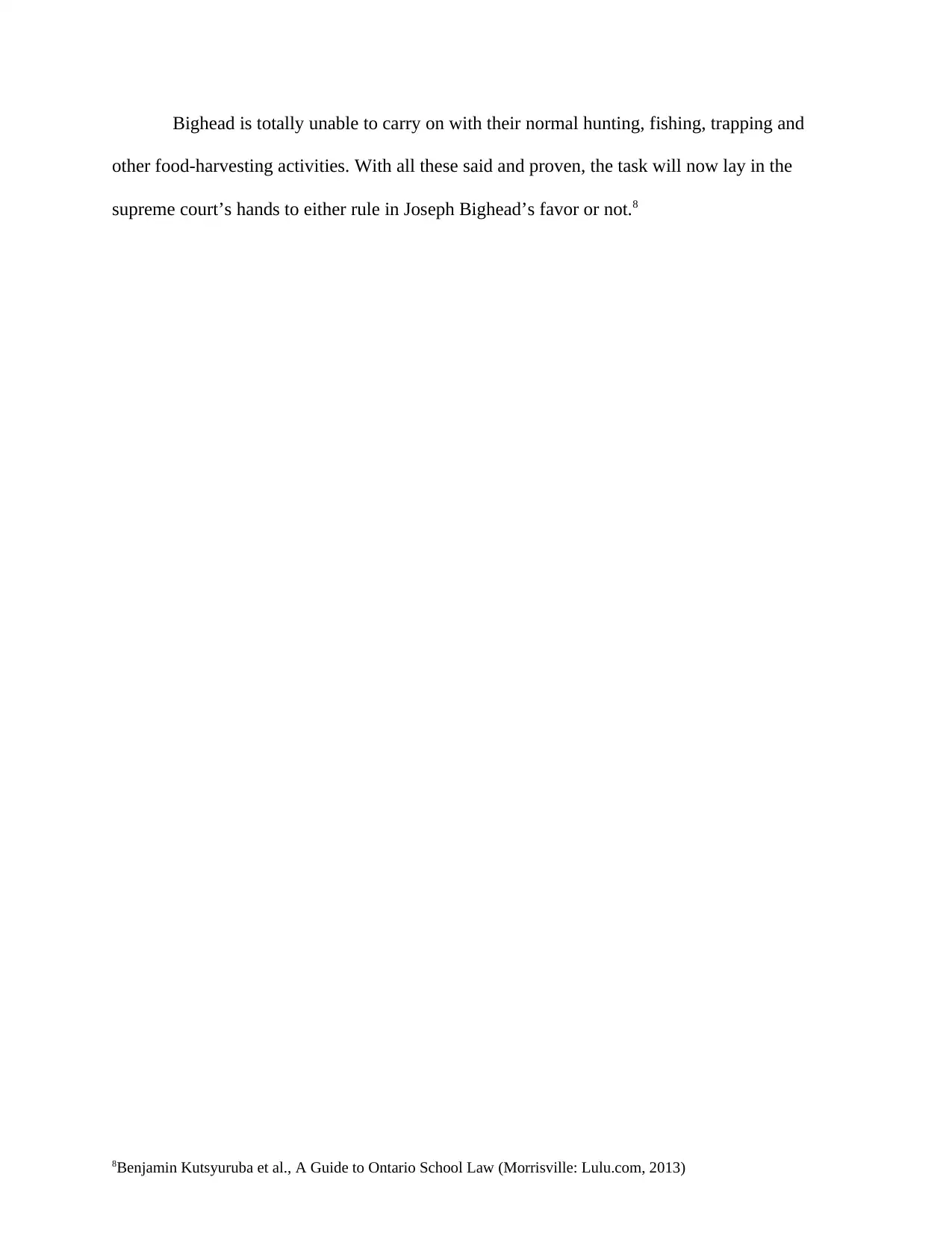
Bighead is totally unable to carry on with their normal hunting, fishing, trapping and
other food-harvesting activities. With all these said and proven, the task will now lay in the
supreme court’s hands to either rule in Joseph Bighead’s favor or not.8
8Benjamin Kutsyuruba et al., A Guide to Ontario School Law (Morrisville: Lulu.com, 2013)
other food-harvesting activities. With all these said and proven, the task will now lay in the
supreme court’s hands to either rule in Joseph Bighead’s favor or not.8
8Benjamin Kutsyuruba et al., A Guide to Ontario School Law (Morrisville: Lulu.com, 2013)
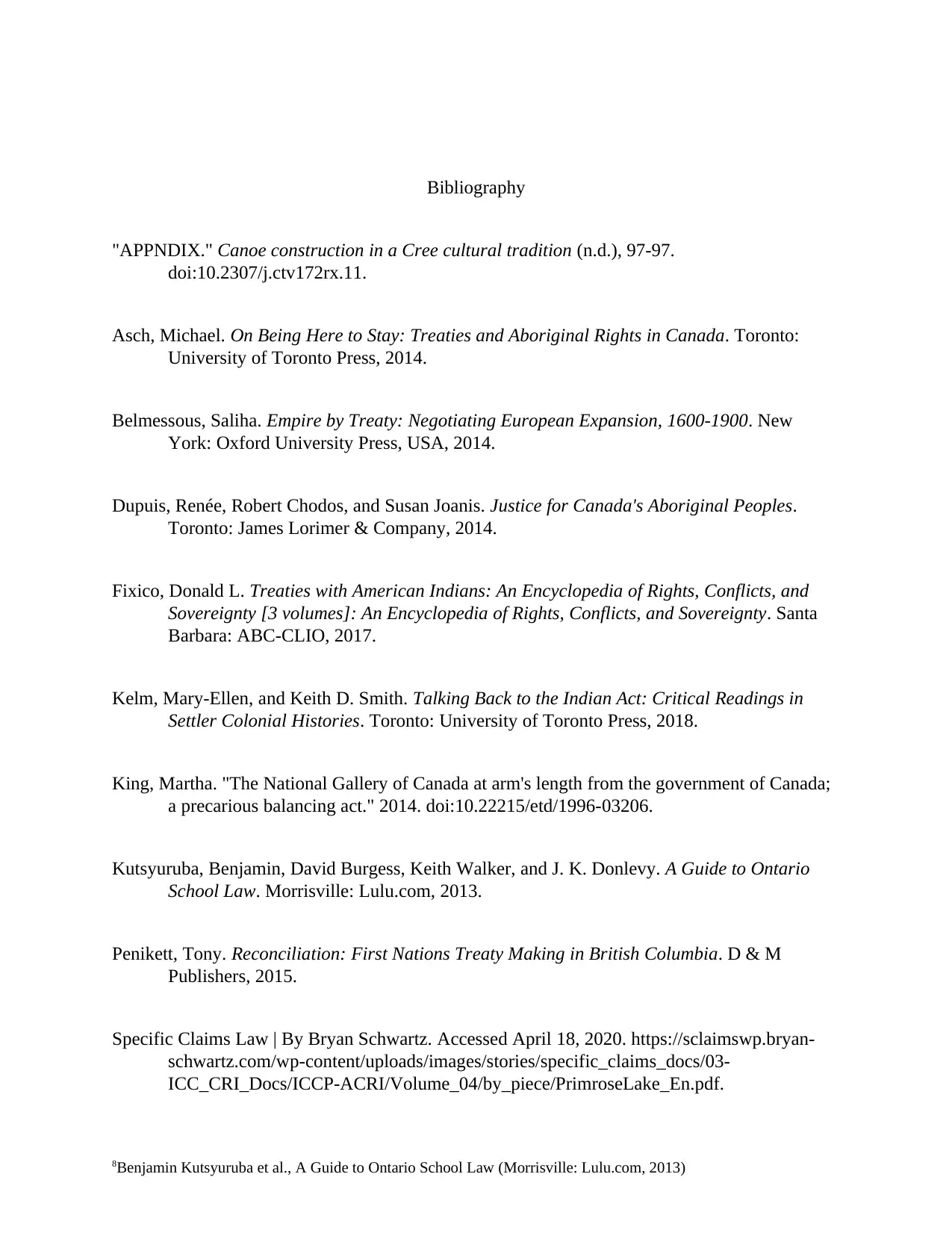
Bibliography
"APPNDIX." Canoe construction in a Cree cultural tradition (n.d.), 97-97.
doi:10.2307/j.ctv172rx.11.
Asch, Michael. On Being Here to Stay: Treaties and Aboriginal Rights in Canada. Toronto:
University of Toronto Press, 2014.
Belmessous, Saliha. Empire by Treaty: Negotiating European Expansion, 1600-1900. New
York: Oxford University Press, USA, 2014.
Dupuis, Renée, Robert Chodos, and Susan Joanis. Justice for Canada's Aboriginal Peoples.
Toronto: James Lorimer & Company, 2014.
Fixico, Donald L. Treaties with American Indians: An Encyclopedia of Rights, Conflicts, and
Sovereignty [3 volumes]: An Encyclopedia of Rights, Conflicts, and Sovereignty. Santa
Barbara: ABC-CLIO, 2017.
Kelm, Mary-Ellen, and Keith D. Smith. Talking Back to the Indian Act: Critical Readings in
Settler Colonial Histories. Toronto: University of Toronto Press, 2018.
King, Martha. "The National Gallery of Canada at arm's length from the government of Canada;
a precarious balancing act." 2014. doi:10.22215/etd/1996-03206.
Kutsyuruba, Benjamin, David Burgess, Keith Walker, and J. K. Donlevy. A Guide to Ontario
School Law. Morrisville: Lulu.com, 2013.
Penikett, Tony. Reconciliation: First Nations Treaty Making in British Columbia. D & M
Publishers, 2015.
Specific Claims Law | By Bryan Schwartz. Accessed April 18, 2020. https://sclaimswp.bryan-
schwartz.com/wp-content/uploads/images/stories/specific_claims_docs/03-
ICC_CRI_Docs/ICCP-ACRI/Volume_04/by_piece/PrimroseLake_En.pdf.
8Benjamin Kutsyuruba et al., A Guide to Ontario School Law (Morrisville: Lulu.com, 2013)
"APPNDIX." Canoe construction in a Cree cultural tradition (n.d.), 97-97.
doi:10.2307/j.ctv172rx.11.
Asch, Michael. On Being Here to Stay: Treaties and Aboriginal Rights in Canada. Toronto:
University of Toronto Press, 2014.
Belmessous, Saliha. Empire by Treaty: Negotiating European Expansion, 1600-1900. New
York: Oxford University Press, USA, 2014.
Dupuis, Renée, Robert Chodos, and Susan Joanis. Justice for Canada's Aboriginal Peoples.
Toronto: James Lorimer & Company, 2014.
Fixico, Donald L. Treaties with American Indians: An Encyclopedia of Rights, Conflicts, and
Sovereignty [3 volumes]: An Encyclopedia of Rights, Conflicts, and Sovereignty. Santa
Barbara: ABC-CLIO, 2017.
Kelm, Mary-Ellen, and Keith D. Smith. Talking Back to the Indian Act: Critical Readings in
Settler Colonial Histories. Toronto: University of Toronto Press, 2018.
King, Martha. "The National Gallery of Canada at arm's length from the government of Canada;
a precarious balancing act." 2014. doi:10.22215/etd/1996-03206.
Kutsyuruba, Benjamin, David Burgess, Keith Walker, and J. K. Donlevy. A Guide to Ontario
School Law. Morrisville: Lulu.com, 2013.
Penikett, Tony. Reconciliation: First Nations Treaty Making in British Columbia. D & M
Publishers, 2015.
Specific Claims Law | By Bryan Schwartz. Accessed April 18, 2020. https://sclaimswp.bryan-
schwartz.com/wp-content/uploads/images/stories/specific_claims_docs/03-
ICC_CRI_Docs/ICCP-ACRI/Volume_04/by_piece/PrimroseLake_En.pdf.
8Benjamin Kutsyuruba et al., A Guide to Ontario School Law (Morrisville: Lulu.com, 2013)
1 out of 9
Your All-in-One AI-Powered Toolkit for Academic Success.
+13062052269
info@desklib.com
Available 24*7 on WhatsApp / Email
![[object Object]](/_next/static/media/star-bottom.7253800d.svg)
Unlock your academic potential
© 2024 | Zucol Services PVT LTD | All rights reserved.